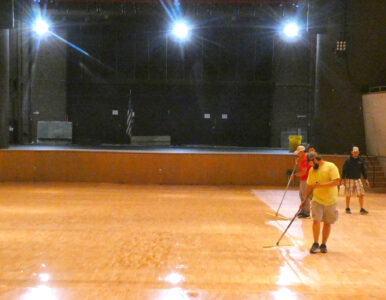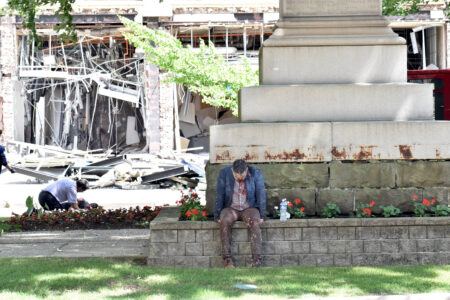Packard Music Hall refurbishes floor
Stakeholders hope to raise funds to replace original seating

Staff photo / Andy Gray A crew applies a coat of sealant on the main floor at Packard Music Hall in Warren on Thursday.
WARREN — Like many approaching a 70th birthday, Packard Music Hall is getting a facelift, or in its case, a floor buff.
Both the stage and the main floor in the performance venue that opened on Oct. 15, 1955, have been stripped, sanded and resealed over the last two weeks.
The floor is the latest improvement at the music hall, following the addition of an elevator in 2018, a new marquee with color display in 2019 and the installation of handrails in the balcony. The project was funded by the building’s five stakeholders — Packard Park and Music Hall Board of Trustees; the city of Warren, which owns the building; JAC Management, which has a contract with the city to operate it; the W.D. Packard Concert Band, for which the hall was built at the bequest of William Doud Packard; and the W.D. Packard Foundation, a nonprofit group dedicated to ensuring the future of the landmarks left behind by Packard.
“All the parties worked together to make a very nice improvement for the citizens of Warren,” said Dennis A. Rossi, president of the board of trustees and a member of the foundation board.
The floor project was conceived as the foundation considered a loftier goal — replacing the seating.
The hall is a multi-purpose venue. The main floor has temporary seating that can be set up for concerts and theatrical performances on the stage, and those seats can be removed so the floor can be filled with everything from tables for a banquet to a ring for boxing and professional wrestling.
Those temporary seats turn 70 in October as well. They’ve been recovered — the seats originally were green, according to Thomas A. Groth, executive director of the band — but the metal frames are heavy, and the seats are joined together in pairs, which makes them even heavier and more difficult to move. Recovering doesn’t change the infrastructure underneath, and attendees sometimes complain they can feel the springs inside them.
The average person also is bigger in 2025 than in 1955. The seat width for the permanent seats upstairs is 15 inches. With new seats and more modern frames, they would increase width to 18 inches and still keep the same number of permanent seats, according to foundation President Richard Baker. However, replacing all 2,000-plus permanent and temporary seats will cost at least $750,000, and that estimate is two years old.
“It’s going to take a hot minute to raise that much money, so what we wanted to do was whet everybody’s appetite and go, ‘Look, we’re starting to make this better,'” Baker said. “We wanted to get the ball rolling with something that people could see where the money that has been donated up to this point has gone and that it’s still a very viable thing.”
Rossi said in a separate interview, “If we’re going to get seats, we’re going to have to fix the floor first. So we thought this is a more practical project to pull off.”
And the floor definitely needed refinished.
“I don’t remember it ever being done before. It just needed it,” said Groth, who played his first concert with the band in 1959. “The stage takes a beating with all of the different groups that come in and so forth. And, of course, with the audience traffic out there, it just takes a beating. The music hall is a great gift from W.D. Packard, and we’ve got to do our part to try to keep it up and make sure it’s still a viable performing hall for everybody.”
Baker is a lifelong Warren resident, and he started volunteering with the foundation because he’s been going to the music hall since he was a child and didn’t want to see the venue left behind as revitalization efforts have been focused on downtown Warren.
“It’s a cornerstone of the community that deserves to be at its best,” Baker said.



